Foreign Insulators
by Marilyn Albers
Reprinted from "Crown Jewels of the Wire", April 1990, page 3
THE MYSTERIOUS EAVED INSULATOR
SOME BACKGROUND
If you are a long time collector and have been observant, you will recognize
the insulator drawing shown below. It appeared in Jack Tod's column three
different times back when he was writing "Porcelain Insulator News"
for Crown Jewels magazine. In the November 1974 issue, Dick Alumbaugh
(Anaheim, CA)
wrote to Jack and included a photo and drawing of this insulator he'd found. It
was white porcelain and it had the circle-B marking stamped five times on the
inside of the outer petticoat. Dick did not know the origin of the piece and
Jack refused to guess, but of one thing he was certain -- it was not the mark of
Ohio Brass. This company began use of an embossed (not stamped) B within an oval
in 1907 but the eaved insulator was designed and put into use about three years
before that time, as you will read later on in this article.
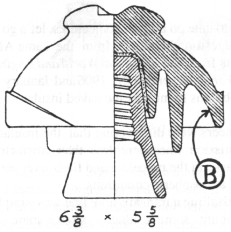 |

Ohio Brass Trademark
|
Then Matt Grayson (Roslyn, NY) sent Jack some prints of the articles from old
AIEE journals (American Institute of Electrical Engineers) and in going through
them, one of them in particular caught his eye. It concerned construction
practices on European transmission lines. Among the several insulators pictured
in the article, Jack was surprised to see the Alumbaugh unit once again. Here it
was represented as a European style! The clouds surrounding this mysterious
insulator were beginning to lift and Jack's September 1978 column reflected his
enthusiasm. He said, "We'll have more coming on it in upcoming
issues".
It took five years, but more was reported about it in the December
1983 issue of Crown Jewels. Mark Willke (Silverton, OR) had written to Jack and
was feeling lucky to have found "one of the old insulators with the eaves
around the skirt". Especially since it had cost him a mere $5 at a
second-hand store. The owner said it was Canadian. No doubt it was the same
insulator reported in November, 1974 and September, 1978 but his piece was
stamped with the circle B-marking one time, not five. Mark questioned how it was
possible to stamp any marking on the inside of the outer shell, and it struck
him as odd that only the bases of the two inner petticoats were unglazed.
Jack's
answer was "the fact that you say the inner petticoats have a firing rest
is a pretty good indication that it was made by glazewelding of several shells
together. Your insulator's style resembles insulators made in the late 1890's,
and all such large insulators made then were made by glazewelding shells.
If it
indeed was a glazeweld, it is understandable that the circle-B marking could
have easily and normally been applied to the inside of the outer shell. Furthermore, this was par for the course on many items as a device for indicating
different part sizes (for stocking purposes) when they were later assembled.
By
the way, even though we don't know the origin (foreign?) of this insulator, I'd
still say it is a good item due to its obvious antiquity. Your $5 purchase price
would seem to fall in the bargain category." And the case rested...
IS IT ITALIAN?
Now that you've been brought up to date on all past conjectures, let's go on.
I must tell you that I have also been digesting the article from the same AIEE
journal of 1904 as well as some excerpts from the Electrical World and Engineer
(November 24,1900) and Electrical World (December22, l9O6and January 26, 1907).
From what I read, it seems obvious to me that the caved insulator is of European
origin. Read on.
In the late 1800's European engineers were discovering that the
insulators originally used on the electric transmission lines were less than
satisfactory. Breakdowns were frequent due to cracks in the porcelain and
flash-over across the surface of the insulator caused by atmospheric conditions.
It has always been thought that installing a transmission line was simple -- just
put up a few wooden poles, mount some insulators, stretch some wire and zap,
that was that, simplest part, no problem! But their views had been too
simplistic, and as engineers wisely began to study all the components of the
circuit, they came to realize that problems could not all be blamed on the
weather! Perhaps the design of the insulators was at fault?
This became most
apparent in 1895 after the installation of the line running from the large
Italian plant for generation of electrical energy at Paderno, Italy, and its transmission to Milan and adjoining districts. It had been
constructed in accordance with these new considerations and problems were being
overcome. There were improvements in the methods of testing the insulators;
multiparts no longer split apart once a cement was used that did not swell with
increasing temperatures; maintenance costs were reduced when iron poles were
used instead of wooden ones and these gave no problem when suitable insulators
were used. The list went on and on.
I quote directly from the November 24, 1900 article in Electrical World and
Engineer, which speaks of the insulators used on
the Paderno line: "Several tests have been made on different types of
insulators by means of a transformer giving up to 50,000 volts. Under such test
the German types were discarded, and the very open and largest American type
selected. Three varieties of this type are used on the line, designed by Engineer
Semenza and manufactured by Messrs. Richard Ginori, of Milan. The first consists
of two parts separately constructed; the second represents all that can be
desired with reference to shape to prevent disruptive discharges, and the third
type is a combination of the two former.
One thousand seven hundred and fifty of the first type are employed, and none were rejected on test. Of the second
type 3500 are employed, and only 6 were perforated on test." The three varieties
of Semenza insulators are shown in the drawings below. Recognize type #1 in the
center. That's our eaved insulator again.
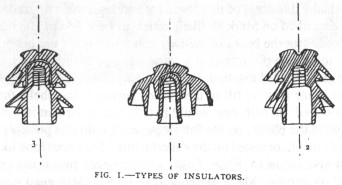
Incidentally, Signor Guido Semenza was secretary of the Italian Institution
of Electrical Engineers and he worked right along with the engineers of the
Societa Ceramica Richard-Ginori during these test. After a great number of
experimental trials made at the electrical testing laboratory connected with the
works of that company at Doccia, near Florence, Mr. Semenza stated that his
conical type #2 insulator was chosen as the standard Paderno bell. A triple
petticoat was used, with two of these cemented together as one six petticoat
insulator. These were put into service in 1904. Some slight variation in design
and size were made to accommodate from 6,000 to 50,000 volts.
It was implied
that the eaved insulator (type #1) was not recommended by Semenza after all because
the petticoats were glazewelded together, hence
it was not actually a two-piece insulator. He preferred to get them from the
factory in separate pieces. "In testing an insulator of two or more
pieces", he said, "one layer of porcelain may be cracked but is
protected by the other layers. When the test are performed on the single
composing parts, this cannot happen, and one is sure to have the insulators made
up of sound parts."
So what happened to the 1,750 eaved insulators that
were tested on the Paderno line? Were they scrapped and are they extinct in
Europe now? Or could they have been salvaged and sent to another location, say
Canada, where they perfectly suited the needs of that country? That's very
possible, because it just so happens that Robin Harrison (Seattle, WA) has found
some in service there!
FROM PADERNO BELL TO "KOOTENAY WHITE"
Robin wrote to me in November 1988 reporting on several new insulator finds
and included a photograph of a piece he was particularly proud of. He described
it as "an interesting and well made insulator that shows up periodically
in
Canada(!). The quality of the porcelain and glaze appear to be European in
origin as with many other insulators used in Canada. They are unmarked and
appear to be old. I have seen them on lines containing Redlands and Imperial
porcelain. It is a two piece item with the inner skirt cemented into the two
skirt upper portion and has eaves on either side".
Robin had a duplicate of
this insulator and I was able to trade for it. It is exactly as described on
Mark Willke's letter to Jack Tod in 1983, except that it is not marked. But the
bases of the two inner petticoats are unglazed. And it "appears" to be
two piece, but it's very possible that the skirts of the upper portion are
glazewelded together. It is not always possible to tell just by looking because
the glaze may so fill in the spaces between the shells that unless the insulator
is sawed in half, one would bet his last dollar that it is all one piece. Have a
look at the photos on the follow page. Could this possibly be the same as the
type #1 insulator tested on the Paderno line? Sure does look like it, doesn't
it? I must give credit to Elton Gish, our porcelain multi-part expert, for the
excellent photography. Much to my delight, he has catalogued it as M-2150!
Robin
wrote "Your specimen I got from a collector in Penticton, British Columbia
(hence the sticker with 3-C on the lower portion of the insulator in the
photos), but mine was found along the coast there where some are still in
service, according to the dealer I got it from in Enumclaw. I suspect that these
may have been widely used throughout British Columbia on early power
lines."
"They are still in use on at least two lines on the outskirts
of Penticton. The ones I saw were used on secondary, lower crossarms, two to a
pole, alternating with other secondary power pieces. The alternate insulators
appeared to be a mixture of old power pieces and new Hi-tops. The new high
power part of the line was carried on the pole top and top crossarm and
consisted of modern post type insulators and big multiparts".
THE "KOOTENAY WHITE" INSULATOR M-2150
During the summer of 1989, Robin returned to southern British Columbia for
what he called "a rapid pace history expedition" He wrote to say the
trip was successful in that he had picked up three more of the eaved insulators,
also unmarked, and had been able to take photos of these on the line.
Unfortunately, he was leaving the next day for a month at sea and there was not
time to get the film developed. Robin is a marine biologist.
The next letter
came in October, 1989. After weeks of waiting for his film to be processed (me,
too), he found that all of the black and white pictures he'd taken with a
telephoto lens were over exposed and pretty well useless. He was crestfallen.
But he did get some color shots of the lines and the insulators on them. Those
that were clear enough to print follow along with Robin's descriptions. All of
the photos were taken in the hills surrounding Penticton, British Columbia.
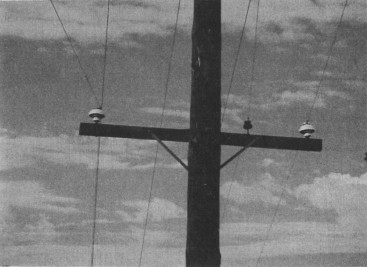
The eaved insulators with a more modern insulator in brown, maybe U-2421,
lower crossarm, secondary circuit. The linemen refer to the eaved insulators as
the Kootenay whites. The name comes from the West Kootenay Power Company in
Penticton which uses them and which happens to be west of Kootenay Lake in
southern British Columbia.
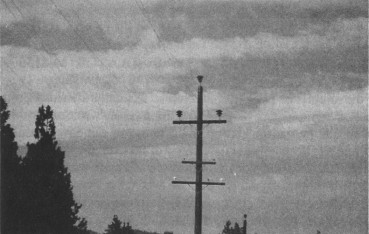
A nearby pole showing the total configuration of insulators. The top ones are
brown metal capped multiparts, very likely made by Ohio Brass. I saw these at
power stations I stopped at. The others are "lbi's" (little brown
insulators!).
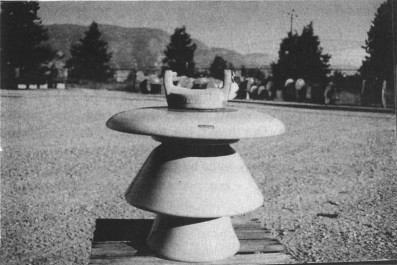
A close-up of the only white metal capped multipart insulator that appeared
on the top cross arm of one of the poles. A kind power foreman uncrated this
insulator and helped me set it up for photography. It is a new Brazilian marking --
SANTANA / 88 / BRASIL. (Note: We have recently seen several styles of these
insulators from Brazil with this marking and are not on the trail for more
information on this company. Notice that their word for Brazil is spelled with
an "S". --Marilyn)
Robin passed on a few more thoughts in regard to the Kootenay whites. He
said, 'As far as l could find out from the power companies in the Okanaga Valley
(wherein lies Penticton), they were first used to transfer power to Rossland
from several dams in southeastern British Columbia. I was told that this
insulator was designed especially for this line, but now with the evidence from
all the research, I suspect this claim. They said that this was a very
dependable insulator, and rarely had to be replaced due to failure (thus the
ones still in use). The insulators were ordered for that purpose, or may have
been discards from an upgrade of the Rossland Lines. This is my conjecture. I
regret to say that every station I visited had dumped all their extra insulators
during a company wide 'clean-up' earlier this year, so l was only able to
scrounge up a few that had been squirreled away. One fellow told me had two palettes of insulators, but they were gone when we went out to look... .he thought
they must have been dumped fairly recently."
"My next step is to
contact a retired power man in eastern British Columbia to whom I was referred
by a fellow in Oliver, B.C. This man apparently is an amateur historian of the
old power in southern British Columbia. He may have more information on the
history. I still need to follow up on two rumors: One fellow told me that he was
positive that he had seen brown Kootenays in eastern British Columbia. I suspect
that he may have been confused with the U-964 VICTOR and No Name insulators which are
superficially similar. The second
rumor is that one small substation in eastern British Columbia may still have
all the old records and catalogs from the early days. This would be a great
find, if true. If I could gain access to some of these catalogs, we might get a
windfall of information!"
Robin, thank you so much for all your research in
the past few months and we'll keep our fingers crossed that you are able to find
those old records and catalogs. Keep in touch. Our thanks, too, to Elton for the
seeds he planted by sharing his information on the Semenza insulator, also for
the photos, and for adding dignity to our Kootenay white by giving it a
M-number.
| 